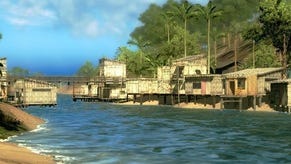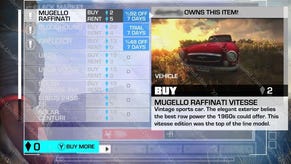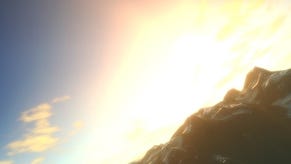Just Cause 2
Jump for joy.
What's more, traversing the space is quick, seamless and joyous. The grappling hook, now permanently mapped to a shoulder button, is used to catapult Rodriguez around the world; in conjunction with his endless supply of parachutes, it can gain him instant height and momentum from a standing start. While it's possible to walk up to a car, Nico Bellic-style, and pull the driver out to take his place, now you can also simply hook yourself on to a speeding vehicle, spring onto its bonnet and either enjoy the ride as a surfer, or swing through the side door window to take the wheel.
And what if your destination is measured in long kilometres? A tap of a button will call in a friendly black market dealer, who, for a price, will drop a jet or a helicopter nearby for you to take to the skies in. Sometimes the jet will land on top of a passing car, or will fall awkwardly in front of a wall. But with the grappling hook, you can tether it to another vehicle, pull it free of the obstruction and be off in 30 seconds.
Everything is designed to propel you forward through the game world as effortlessly as possible. Aim your grappling target at the top of a plane tree and, as you catapult towards it, the game will shift your position slightly to the left or the right so you don't snag annoyingly in the branches.
A cross between Spider-man and Bionic Commando, Rico Rodriguez provides, via this one tool, the most versatile avatar for a player yet seen. The throb of an antagonistic military helicopter is no longer a trigger to seek out cover. Rather, you angle your view to the skies, take aim, and haul yourself towards its cockpit for a mid-air hijacking that even an awkward QTE can't spoil.

As a playground for the imagination, too, the island of Panau and the systems that inhabit it are near-unrivalled. You'll lose hours to messing about with your hook and parachutes, roping enemy soldiers to passing vehicles and watching them puppet dance along the tarmac, or simply putting single bullets in gas canisters and admiring their spasmodic pin-balling around the scenery. The personal stories that emerge, especially through the first few hours of play - which are when you're most likely to ignore the structured missions and simply explore - will fill playgrounds and forum threads in weeks to come, not to mention YouTube channels if the community embraces the PlayStation 3 version's video capture capability.
Panau is caught in the formative stages of a tussle between nature and civilisation. Rodriguez's mission (in systematic terms, if not narrative terms) is to destroy almost all trace of man's involvement on the island. Anything marked with the Panau government's bold logo - from radio masts to generators to anti-aircraft guns - is cannon fodder, and as a result violence is the interactive hallmark of the experience. Indeed, every explosion you set off is measured in "chaos", a quantifier for the destruction you wreak upon the island that fills a gauge, unlocking new weapons, vehicles and missions as it passes preset thresholds.








